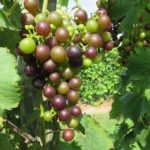As the spray season approaches, it is good to remember the profound impact water quality has on the performance of pesticides used by fruit growers. Purdue Pesticides Program recently published a guide, The Impact of Water Quality on Pesticide Performance PPP-86, available at the Education Store, 1-888-EXT-INFO or www.extension.purdue.edu/store/. I highly recommend this guide to[Read More…]
Strawberry
The results of a historical primate behavior analysis suggest that species with fruit-filled diets evolved larger brains. A popular theory among evolutionary biologists is that we have our sociability to thank for our big brains. This “social brain hypothesis” suggests that the mental effort involved in interacting with others eventually increased our cognitive capacity. However,[Read More…]
Following a very early warm-up, temperatures cooled off the middle of March slowing crop development and bringing us back closer to normal. In southern areas, peaches are in full bloom, but only just showing a little pink in more northern areas. Apples are still in tight cluster and probably at least 10 days from full[Read More…]
The proper time to remove straw from matted row strawberries is when the bare-soil temperature at 4 inches averages about 40-43˚F. This usually coincides with mid to late March in central Indiana. This year is earlier than average with soil temperatures well into the 50s in early March, but they dropped back below 40 during[Read More…]
June bearing strawberries are “short day” plants that set flower buds in response to short days. As we get into late summer, days shorten and strawberry plants respond by setting the flower buds that will result in the crop next spring. It is important to maintain appropriate nutrition and soil water status during this time.[Read More…]
Plant nutritional status is important for all phases of plant growth and has a direct effect on vigor, fruitfulness, cold hardiness, and other factors. Tissue analysis is the most reliable means of determining plant nutritional status. Combined with soil testing, tissue analysis can help pinpoint the source of problems and determine what measures may be[Read More…]
Grape harvest has began in the southern part of the state and will begin in central areas over the next week or so. Early varieties are nearing full maturity while late varieties are just at, or not yet at veraison. Overall fruit quality looks excellent. Apple harvest continues. Summer varieties are mostly done and early[Read More…]
Mites continue to be a concern for both fruit and vegetable growers. We are just now at the historical peak population time for European red mites. Fruit growers should be scouting their more susceptible blocks regularly for the next few weeks. The thresholds for treatment increase as we get later in the season. See https://extension.entm.purdue.edu/publications/E-258/E-258.html[Read More…]
We are familiar with strawberries grown as a perennial crop in Indiana. Bare root strawberry plants are set in the spring. Fruit is first harvested in the second year and the planting is renovated annually. Using this system, strawberry seasons last for three to four weeks from middle May through June. The traditional system has been[Read More…]
Approximately 40 growers attended the Society’s summer field day a couple of weeks ago. Thanks go to David, Valerie and Theresa Doud for being wonderful hosts. We saw apples, peaches and strawberries, and also some of the new MAIA apple selections being developed. After lunch we visited Cordes Berry Farm which consists of over 9[Read More…]




